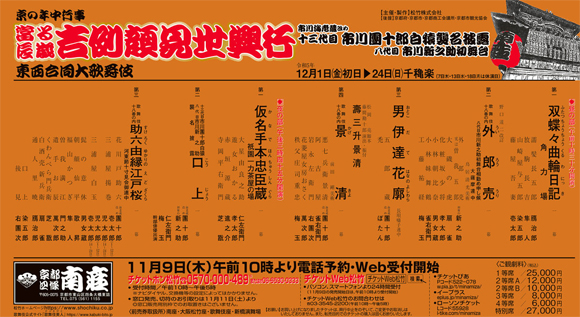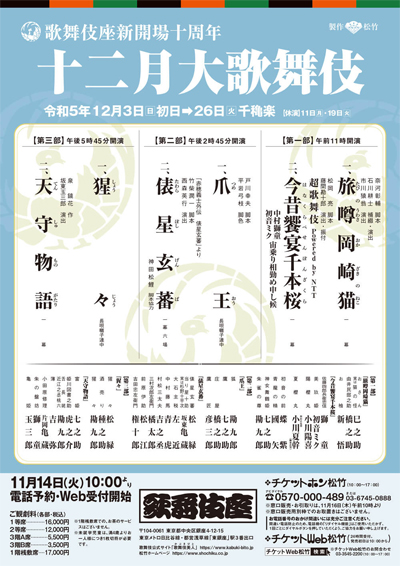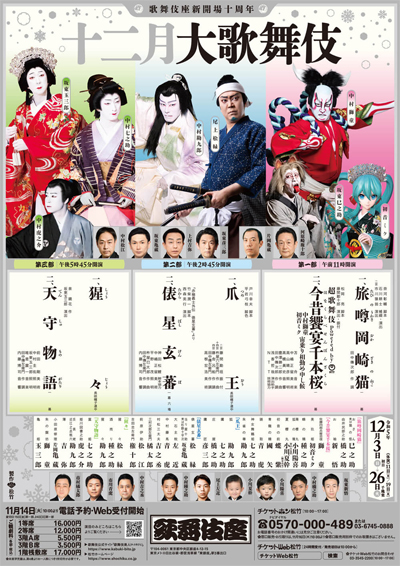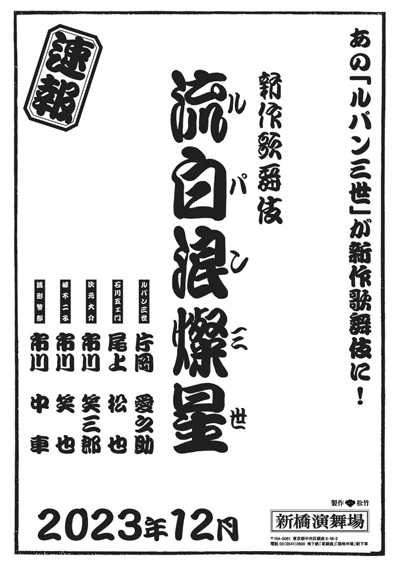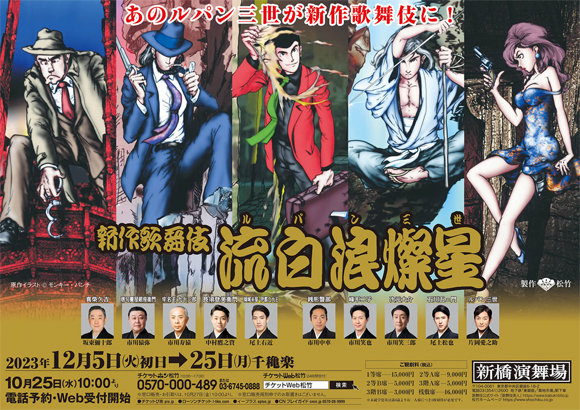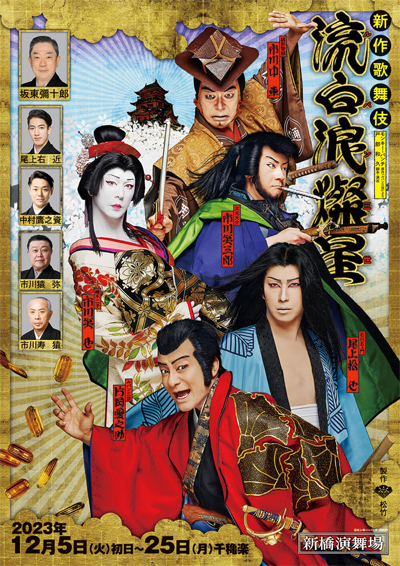| Comments |
The traditional kaomise in Ky˘to at the Minamiza
with the shűmei of Ichikawa Danjűr˘ XIII and the
hatsubutai of Ichikawa Shinnosuke VIII.
Sum˘ba:
"Futatsu Ch˘ch˘" means "two butterflies" and also comes from the fact that
two sum˘ wrestlers who play important
roles in the full length play have names beginning with "ch˘":
Ch˘kichi and Ch˘gor˘. In order to help his master Yamazakiya Yogor˘ (Ichikawa Somegor˘) buy out the contract of the
beautiful Azuma (Nakamura Kazutar˘), the senior wrestler Nuregami Ch˘gor˘ throws a match,
letting the younger wrestler Hanaregoma Ch˘kichi win, hoping to get his help.
But Ch˘kichi loses his temper and the two end up competing in a test of pride.
Starring popular actor Nakamura Ganjir˘ as Ch˘gor˘ and Nakamura Hayato as Ch˘kichi.
Uir˘ Uri: there are many plays based on the revenge by the Soga brothers
on Kud˘ Suketsune (Living National Treasure Nakamura Baigyoku), the man that arranged to have their father killed.
In this particular play, this dramatic fight is transformed into light fantasy
by showing one of the Soga brothers disguised as a peddler of uir˘, a medicine
that makes it possible to speak quickly and elegantly. The highlight of the
play is a long speech full of puns and wordplays. Starring Ichikawa Shinnosuke as the peddler.
Featuring also Nakamura Jakuemon, Nakamura Senjaku and Kataoka Takatar˘.
Otokodate Hana no Yoshiwara: Gosho no Goroz˘ (Ichikawa Danjűr˘), the most gallant and chivalrous of men in the capital
of Edo, is off to the bustling Nakanoch˘ corner of the
Yoshiwara pleasure district. He has received a love letter from his
lover, a famous keisei in Yoshiwara.
Goroz˘ tells us the story of how they met and their many rendezvous in a dance. On his way, he is ambushed by
men who hold a grudge against him, but Goroz˘ effortlessly fends them off and continues on his way to his beloved.
Kagekiyo: The powerful Heike warrior Akushichiby˘e Kagekiyo (Ichikawa Danjűr˘)
is captured and imprisoned by his enemies, the Genji clan. He uses his superhuman strength
to smash his way out of his prison cell, and then struggles with his enemies in a violent and spectacular tachimawari.
Featuring also Living National Treasure Nakamura Baigyoku (Chichibu Sh˘ji Shigetada), Nakamura Jakuemon (Akoya) and Ichikawa Udanji (Iwanaga Saemon).
A rare play from Kabuki Jűhachiban,
the collection of the Eighteen Favorite Plays of the Ichikawa Family.
Gion Ichiriki Jaya: "Chűshingura" is one of
the most popular plays in the theatre and shows a true event when forty-seven
masterless samurai avenged the death of their lord by killing his enemy.
The seventh act is one of the most popular and shows the leader of the vendetta
Yuranosuke as he is hiding his intention to avenge his lordĺs death by pretending
to be only interested in pleasure, but also encountering key figures on
his side and the side of the enemy. Yuranosuke (Living National Treasure Kataoka Nizaemon)
spends his days and nights in the pleasure quarters of Ky˘to in an effort to
make their lordĺs enemy, Moron˘, believe he is not planning a vendetta.
His acting is so good that even men in his own group believe he has given his
life up to pleasure. Moron˘ is not so easily convinced, though, and has sent spies,
including a former retainer of their late lord, En'ya Hangan, to find Yuranosuke's
true intentions. Okaru (Kataoka Takatar˘), the wife of one of the retainers is now a
courtesan at the Ichiriki Teahouse, unaware that her husband is dead.
Okaru's brother Heiemon (Nakamura Shikan), a servant in the Hangan household,
has also come to the teahouse and the interaction of these characters
becomes a matter of life and death and ends with Yuranosuke preparing to
lead the vendetta.
K˘j˘: the close relationship between the actors and the audience
is shown by these stage announcements, lavish ceremonies to commemorate various
important events. In this case, all the stars of the cast assemble to celebrate the shűmei of
Ichikawa Danjűr˘ XIII and the hatsubutai of Ichikawa Shinnosuke VIII.
Sukeroku: the dandy Sukeroku is the most famous patron of the
Yoshiwara pleasure quarters.
But his reputation as the lover of Agemaki,
the highest ranking courtesan in the quarter is matched by that of his
tendency to pick fights. In fact, Sukeroku is the samurai Soga no Gor˘
in disguise, and he uses the fights to find a lost heirloom sword.
His search takes place in the colorful atmosphere of the Yoshiwara
where processions of beautiful courtesans compete with the splendor of
cherry blossoms in full bloom. All the top stars in Kabuki appear in
a procession of beautiful, exciting and amusing roles.
Starring Ichikawa Danjűr˘ and Nakamura Kazutar˘/Nakamura Kotar˘ as Hanakawado Sukeroku and Miuraya Agemaki.
Featuring also Ichikawa Omez˘, Ichikawa Monnosuke, Nakamura Senjaku, Nakamura Hayato, Nakamura Kotar˘/Nakamura Kazutar˘, Nakamura Ganjir˘, Nakamura Shikan and Nakamura Kash˘
in the roles of Ikyű, Mank˘, the shirozake seller Shinbŕ, Fukuyama Jukichi, the courtesan Miuraya Shiratama, the passer-by, Kanpera Monbŕ and Asagao Senpei.
Sources: Earphone Guide Website or Sh˘chiku Kabuki Official Website
|

